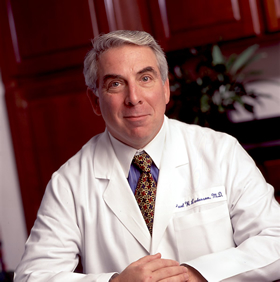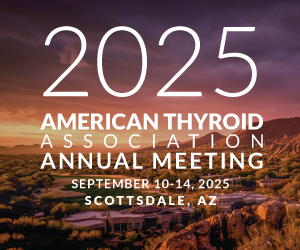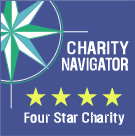 Presented by Paul W. Ladenson, MD
Presented by Paul W. Ladenson, MD
74th Annual Meeting of the American Thyroid Association
Millenium Biltmore Hotel
Los Angeles, California
October 10-13, 2002
Some quiet, but important things have been happening in your American Thyroid Association over the six months since our historic Annual Meeting in Washington, DC. First, our Executive Director Bobbi Smith has completed recruitment of a talented and committed staff. Theresa Ronk joined the ATA from a career in business, where the dot coms’ demise was our good fortune. Theresa devotes herself to our finances and member serviices. Roslyn McKee, who previously worked with Bobbi in the nonprofit sector, is injecting energy and great ideas into our Campaign for Thyroid Discovery, as well as providing general administrative support. If you’ve called or emailed the office, you’ve seen the difference. Bobbi has also directed the enhancement of our website www.thyroid.org, which generates every day greater interest and feedback from the public, press, and our members, who now benefit from a useful private domain where our up-to-the-minute member directory can be accessed for your use in contacting collaborators, referring patients and keeping in touch with other members.
Second, your Public Health Committee, under Ken Burman and Vic Bernet’s direction, have worked hard, fast, and effectively to ensure that ATA has led the way for the nation’s endocrine and medical communities on the timely issue of preventing radioiodine-related injury with potassium iodide. With support from Edie Stern, our able and devoted Director of Public Affairs, the press, Congress and public health authorities now know that the ATA is the source of expertise on this issue. Council has directed the Public Health Committee and staff to convene a one-day Washington conference on this matter on February 28, 2003 to provide public health authorities, Congressional staff, the military, physicians and the public with information on the risks and prevention of radioiodine-related injury. Lew Braverman and John Morris are co-chairing the conference program committee.
Third, the ATA has been collaborating more effectively than ever with others to advance our missions. Your Secretary and Executive Director attended a meeting of the Sister Endocrine Societies–including the Endocrine Society, AACE, Lawson Wilkins, and ten others—to define issues on which we should take conjoint action. The potential threat that reorganization of NIH Study Sections represents for endocrine clinical research was immediately identified as a common concern, and the group has contacted relevant authorities to be certain that our unified voice is heard. David Cooper and Alan Farwell are spearheading an ATA initiative to strengthen ties with patient education groups by forming the Council of Thyroid Societies, which will establish standards for performance and public responsibility. After hearing disappointing news of the Houston-based Thyroid Society’s demise, ATA has worked with their founder Shelly Rubenfeld and board of directors to assume responsibility for the 1-800-THYROID toll-free number and temporarily redirect traffic from their website, which is prominently recognized by the major Internet search engines. In many of our activities, we also rely on partnerships with industry. Our annual meeting, Campaign for Thyroid Discovery, publications and website are all supported by unrestricted grants from multiple sponsors in the pharmaceutical and laboratory industries.
We are a small society, but our influence and impact continue to grow—often due to cooperation with others. I hope that every ATA members will find the occasion to express their gratitude and respect for our collaborators in other professional societies, patient associations and industry. Dream about new ways that we can collaborate with them even more effectively. Without them, the ATA would be a vox clamantis in deserto.






